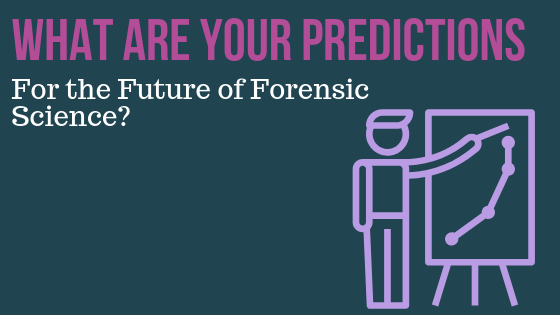Microbiome? Rapid DNA? Investigative genealogy? Isotopes? Read below to see what our ISHI 30 speakers predict for the future of forensic science then join the discussion on our Facebook or Twitter pages to let us know what you anticipate for the future of the field.
 I think the future will be very exciting for forensics. Advancements, such as whole genome testing with next generation sequencing and genealogy will only propel forensics into a world of less doubt. I do, however, miss the art form that was pouring a perfect 377 sequencing gel.
I think the future will be very exciting for forensics. Advancements, such as whole genome testing with next generation sequencing and genealogy will only propel forensics into a world of less doubt. I do, however, miss the art form that was pouring a perfect 377 sequencing gel.
Lisa Mertz, OCME
 We are living in a really interesting time for forensic genetics. The new capabilities of rapid DNA testing, phenotyping and genetic genealogy have opened up so many new possibilities for forensic investigations, and in turn, have created a whirlwind of potential concern and panic regarding genetic privacy and legislation. In the next few years, I think we will see a lot of admissibility hearings and challenges in court. Overall, my prediction is that the field of forensic genetics will continue to evolve, and in a short time, I think we will overcome many of the current challenges faced by analysts in both the generation and interpretation of complex forensic DNA profiles and investigations.
We are living in a really interesting time for forensic genetics. The new capabilities of rapid DNA testing, phenotyping and genetic genealogy have opened up so many new possibilities for forensic investigations, and in turn, have created a whirlwind of potential concern and panic regarding genetic privacy and legislation. In the next few years, I think we will see a lot of admissibility hearings and challenges in court. Overall, my prediction is that the field of forensic genetics will continue to evolve, and in a short time, I think we will overcome many of the current challenges faced by analysts in both the generation and interpretation of complex forensic DNA profiles and investigations.
Nicole Novroski, University of Toronto
 I predict we will move faster, with less effort, and obtain massive amounts of genetic information that may or may not be necessary. I just wonder and worry as to what extent we will continue to push the bar. How much deeper do we really need to dive into the DNA to be able to discern individuals? What secrets might we find and how might those be misused? I worry pushing the limit might bring us more than we bargained for.
I predict we will move faster, with less effort, and obtain massive amounts of genetic information that may or may not be necessary. I just wonder and worry as to what extent we will continue to push the bar. How much deeper do we really need to dive into the DNA to be able to discern individuals? What secrets might we find and how might those be misused? I worry pushing the limit might bring us more than we bargained for.
Brittney Chilton, Washoe County Sheriff’s Office Forensic Science Division
 Slooten (2017) published a paper on identifying common donors in DNA mixtures. Subsequently, this theory was applied by Bright et al. (2019). I predict that in the future this theory may be used on a regular basis to find potential links between cases. However, to the best of my knowledge, this has yet to be applied to real casework. Therefore, I look forward to reading about it first application(s) in casework.
Slooten (2017) published a paper on identifying common donors in DNA mixtures. Subsequently, this theory was applied by Bright et al. (2019). I predict that in the future this theory may be used on a regular basis to find potential links between cases. However, to the best of my knowledge, this has yet to be applied to real casework. Therefore, I look forward to reading about it first application(s) in casework.
Kevin Cheng, Institute of Environmental and Science Research (ESR)
 When I first started at the laboratory I was trained to perform slot blot and poured gels for the 377. I could never have imagined that we would be talking about massively parallel sequencing or forensic genealogy. This is a field where you are always learning whether its new chemistries or instrumentation just like the ANDE 6Ct. It’s one of the things I love about my job.
When I first started at the laboratory I was trained to perform slot blot and poured gels for the 377. I could never have imagined that we would be talking about massively parallel sequencing or forensic genealogy. This is a field where you are always learning whether its new chemistries or instrumentation just like the ANDE 6Ct. It’s one of the things I love about my job.
Regina Wells, Kentucky State Police DNA Database
 This is an exciting time to be in forensic human identification. Not only is routine DNA technology cheaper, faster and better than it’s ever been, we have a plethora of (genetic and non-genetic) forensic techniques now available to us to aid missing persons investigations. I am an advocate for applying an interdisciplinary approach to missing persons identification including newer genetic technologies such as forensic DNA phenotyping and forensic genetic genealogy, as well as non-genetic (and sometimes underutilised) technologies, such as radiocarbon dating and craniofacial reconstructions.
This is an exciting time to be in forensic human identification. Not only is routine DNA technology cheaper, faster and better than it’s ever been, we have a plethora of (genetic and non-genetic) forensic techniques now available to us to aid missing persons investigations. I am an advocate for applying an interdisciplinary approach to missing persons identification including newer genetic technologies such as forensic DNA phenotyping and forensic genetic genealogy, as well as non-genetic (and sometimes underutilised) technologies, such as radiocarbon dating and craniofacial reconstructions.
Jodie Ward, University of Technology Sydney and NSW Health Pathology
WOULD YOU LIKE TO SEE MORE ARTICLES LIKE THIS? SUBSCRIBE TO THE ISHI BLOG BELOW!
SUBSCRIBE NOW!


